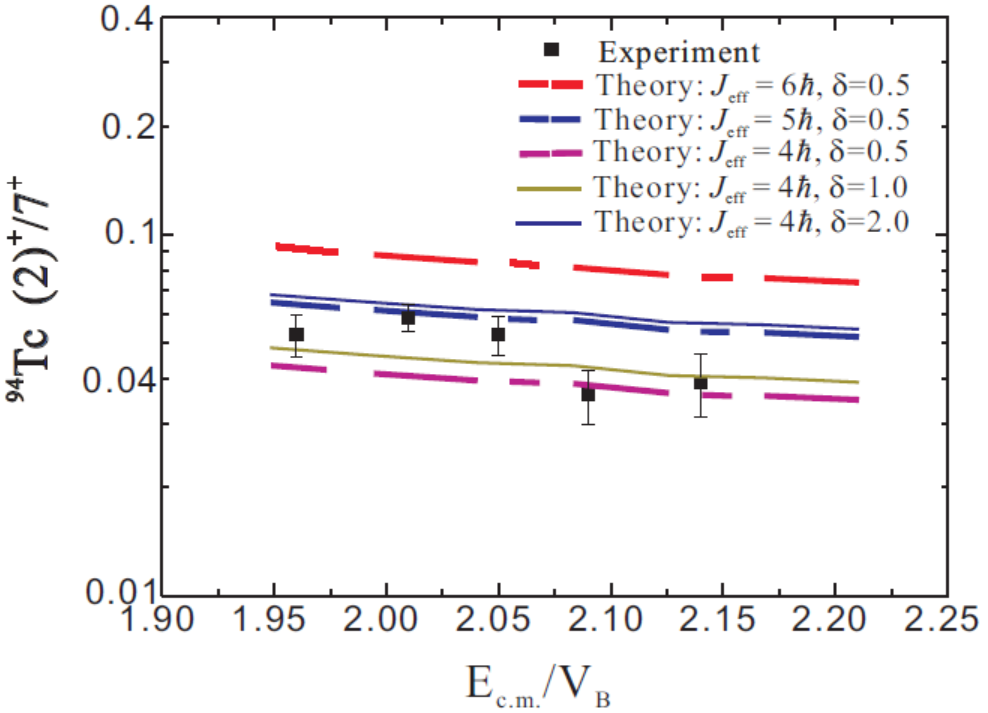A new study sheds light on nuclear reaction production mechanisms of 94Tc nucleus
Scientists from the Institute of Modern Physics (IMP) of the Chinese Academy of Sciences, University of Surrey of UK, and Universidade Federal Fluminense of Brazil have lately made new progress in the study of the production of 94Tc nucleus, a Technetium (Tc) isotope, which is one of the promising candidates for the application of medical diagnostics.
The 94Tc has an isomeric state of (2)+, namely 94Tcm. With large positron branching ratio and medium positron end-point energy, the 94Tcm is a suitable candidate for Positron Emission Tomography, and regarded as an intriguing alternative to many current popular tracers.
Various nuclear reactions have been employed in the production of Tc isotopes. However, most of the studies are based on the light-ion-induced reactions,and thus there is a lack of data based on the heavy-ion-induced reactions.
At Heavy Ion Research Facility in Lanzhou (HIRFL), an experiment with a heavy projectile involved 9Be + 89Y was conducted by the Superheavy Nuclide and Nuclear Structure group of IMP and their collaborators. Researchers applied the online activation method and the offline measurement technique.
The isomer yield ratios, defined as the production of isomeric state of (2)+ (94Tcm) relative to the ground state of 7+ ( 94Tcg), were determined experimentally at different beam energies, using the different characteristic γ-rays from their decays.
Furthermore, scientists have explored the reaction mechanism by employing a phenomenological approach with a cut-off spin and a spreading parameter. An agreement in the order of magnitude between the experimental data and theoretical predictions has been achieved. Possible factors that may affect the isomer yield ratios, such as the γ-quantum and neutrons emitted during the de-excitation of compound nucleus, were also addressed in this study.
The study extends information on the reaction mechanisms and production of 94Tc, a biologically important nucleus.
This work was supported by the Youth Innovation Promotion Association of Chinese Academy of Sciences, the Strategic Priority Research Program of Chinese Academy of Sciences, and the National Natural Science Foundation of China.
The result was published in Physical Review C on November, 12.
Link to the paper: https://journals.aps.org/prc/abstract/10.1103/PhysRevC.102.054607

Fig. 1 Calculated angular momentum distribution for compound nucleus from fusion of 9Be + 89Y system at beam energies of 45.9- and 48.1-MeV. The division of population between the ground 7+ and isomeric (2)+ state at 45.9-MeV is indicated by the blue and red lines. (Image by LI Guangshun)

Fig. 2 Calculated and measured isomer ratios for 94Tc formed through 9Be + 89Y system, assuming different cut-off spin (Jeff) and spreading (δ) values. (Image by LI Guangshun)
Contact :
LIU Fang
Institute of Modern Physics
Email: fangliu@impcas.ac.cn
Reference
Scientists Reveal Reaction Mechanisms of Weakly Bound Projectiles
Scientists from the Institute of Modern Physics ( IMP ) of the Chinese Academy of Sciences and Universidade Federal Fluminense of Brazil lately made progress in the study of reaction mechanisms of weakly bound projectiles .Scientists from IMP launched studies of reaction mechanism of the 9Be + 197Au system , and the systematic properties of 9Be induced reactions at above barrier energies .It was found that , at above barrier energies , the ratios between ICF and TF cross sections for the 9Be + 197Au system were around 40% , slightly higher than the other systems such as 9Be + 208Pb , 186W , and 6 , 7Li + 209Bi , etc .


 甘公网安备 62010202000713号
甘公网安备 62010202000713号


